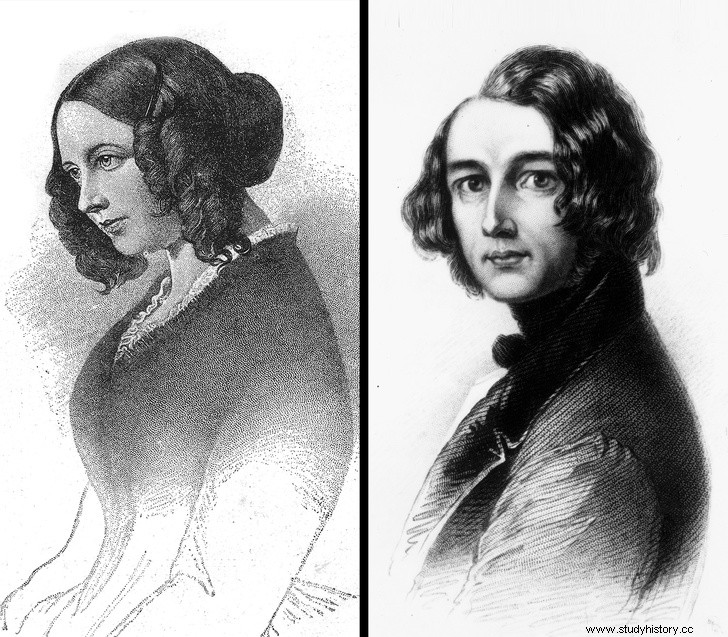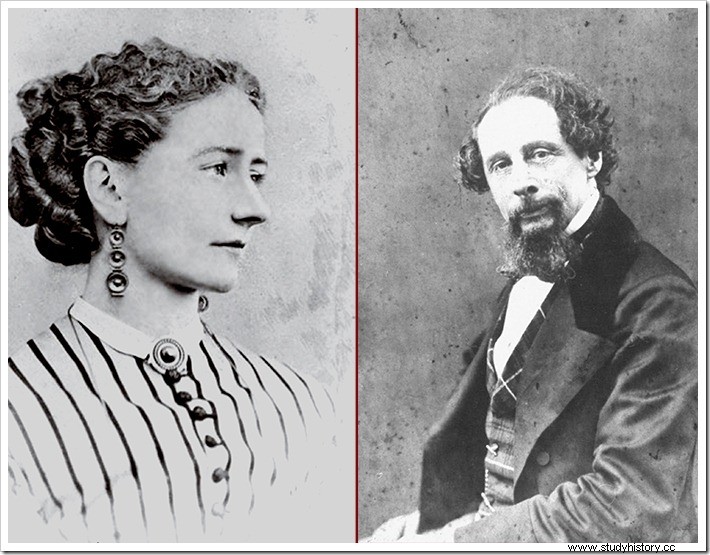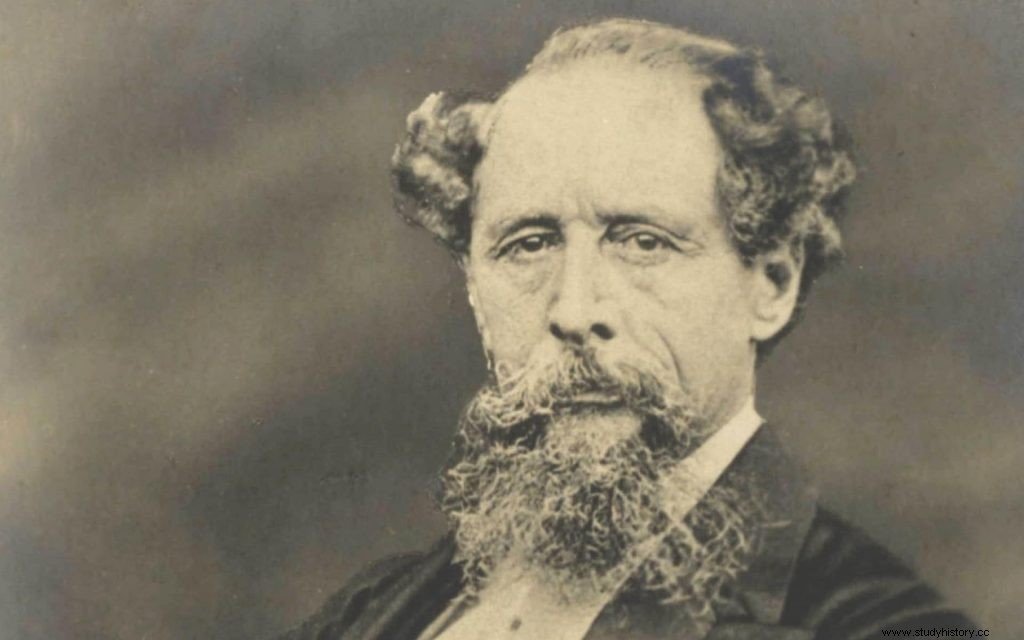In “The Bleak House ”, a novel that Charles Dickens serialized between 1852 and 1853, a detective appeared for the first time. So, following in his footsteps, we will investigate the life and work of Dickens through the women who passed through his life.
In 1836, and after the wedding of Charles Dickens and Catherine Hogarth , he moved in with them Catherine's sister, Mary . Something common at the time, the fact that the single sister accompanied the newlywed to help her in her new life. Coexistence in harmony was accompanied by the first installments of «Boz's notes » and “The Posthumous Papers of the Pickwick Club ”. They were days of wine and roses, until... one night, when they were returning from the theater, Mary suddenly fell ill. Nothing could be done for her, and the next day she died in Dickens's arms, probably from a heart attack. As he held her in her arms, she took from him the ring that Mary wore and that, from that day on, will accompany Dickens throughout his life. He never saw her as her sister-in-law, for him she represented innocence, kindness, tenderness, an almost brotherly love that will remain engraved in her epitaph:
Young, beautiful and good, at the young age of 17 she is already counted among the angels of God.
That painful death and her unfortunate youth will mark her next works, also in installments, “ Oliver Twist ” (1837-1839), “The life and adventures of Nicholas Nickleby ” (1838-1839) and “The Antique Shop ” (1840-1841).

Charles Dickens and Catherine Hogarth
Dickens's youth, in his relationship with women, had a bittersweet flavor, more sour than sweet. To his mother Elizabeth , the first woman who in theory marks us all, never forgave her that after receiving an inheritance for the death of her paternal grandmother, it served to pay the father's debts, which had taken him to prison, but not to get her son out from the factory where he experienced child exploitation first hand. That feeling, close to being an orphan, was reflected in the protagonist of “Oliver Twist ”.
When he began to take control of his life, he was already publishing political chronicles in the Morning Chronicle and later in The Mirror of Parliament, he suffered his first love disappointment because of a tremendously classist society. In 1829 he met a beautiful young woman named Mary Beadnell , with whom he had a four-year relationship. When Dickens was already considering something else, Maria's father, a London banker, objected to that relationship between his daughter and "a simple reporter", and they had to separate. Years later, and both married, they met again and that flame that social differences put out reignited again, but María was no longer that beautiful young woman with whom he had fallen in love.
In Catherine Hogarth he found, more than a wife, a housewife and a mother who would give him 10 children. And in her mother-in-law, the clever editor George Hogarth, the literary godfather who allowed her to put a face and truth to English society through the pseudonym Boz. Although during their years of marriage they saw the light “Cuento de Navidad ”(1843)-his best-known work of him with Mr. Scrooge and the “Bah, claptrap!”-and his great best seller“David Copperfield ” (1849-1850), of which they would sell more than 100,000 copies, their relationship soon deteriorated and was only maintained by the imperatives of a strictly puritanical society. To the point that, for the sake of decorum, he forbade mixing books written by men and women on the same shelf, unless the authors were married. Catherine always proclaimed Dickens's love for her, to the point that on her deathbed in 1879, her dying wish was that the letters Dickens had written to her during her courtship be taken to the British Museum. …
Let the whole world know that he once loved me.
The end of that marriage had a script typical of a novel of entanglement. Dickens ordered a gold bracelet and the jeweller, thinking it was for his wife, delivered it to his house. But that jewel was not for Catherine, it was for Ellen Ternan , a young actress whom Dickens, who had become a theatrical manager, had hired for the play “The Frozen Deep ”. Dickens's explanations were useless, justifying that there was nothing between them and that it was common in the world of entertainment to give gifts to actresses. Dickens and Hogarth separated in 1858, after 22 years of marriage, although they never divorced, something unthinkable at the time and, furthermore, that Victorian society would not have accepted that its great author left his wife and 10 children for a woman 27 years younger than him, According to the letter that Dickens sent to his lawyer Frederic Ouvry, a pension of 600 pounds a year was agreed for his wife and children.

Charles Dickens and Ellen Ternan
Many wanted to see in that 18-year-old girl a memory of her first disappointment or her sister-in-law Mary. The truth is that this relationship is still very confused today and prey to speculation. Even after their separation, Dickens tried to keep her relationship with Nelly, as he called her, a secret, but a railway accident in 1865 uncovered the affair. Returning from France, an accident occurred at Staplehurst in which ten people died and more than fifty were injured. Six wagons fell into the river and a seventh remained suspended in the air, Dickens's and, apparently, Ellen Ternan and her mother. Although he was unharmed in the accident, from that day on he suffered from constant nightmares and various anxiety symptoms. He had already had the idea of returning to the United States for several years - his first trip had been in 1842 with his wife - to see, after the abolition of slavery, the changes in that disappointing slave society that he had reflected in " Notes from America ” -«authoritarian, presumptuous, vulgar, insensitive and above all greedy; Americans weren't English enough «-. In 1867 the trip took place and at a conference in New York he promised to include an appendix in each copy of " Notes of America" , recognizing the change in American society.
Yet another woman would cross her path, Queen Victoria of England . Despite being the standard bearer of the society that he had criticized so much, he received an invitation to attend a private audience with the queen and, out of respect and for the sake of maintaining form, he decided to attend.
On June 9, 1870, due to a stroke, Charles Dickens died.

The father of the social novel knew how to capture a society as advanced as it was hypocritical. After a rapid colonial expansion and significant changes at a social, economic and technological level, which consolidated England as the leading power of its time, a classist, puritanical society was hidden that exploited children in inhuman work, as reflected in “David Copperfield ”, where he uses little David to narrate, in the first person, life from the eyes of a child… his own. His critics, who also had them, used as a recurring argument the fact that Dickens had little training. But he knew how to take advantage of that hindrance to become a great observer of everything around him without created stereotypes and devour the few books that his father did not pawn, such as Don Quixote. In addition to the works already mentioned, it should be added, in the 1950s, “Difficult times ” (about the proletariat and the consequences of brutal industrialization) and “A Tale of Two Cities ” (London and Paris, at the dawn of the French Revolution).
